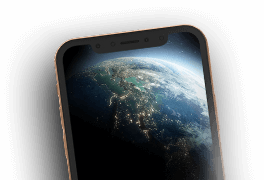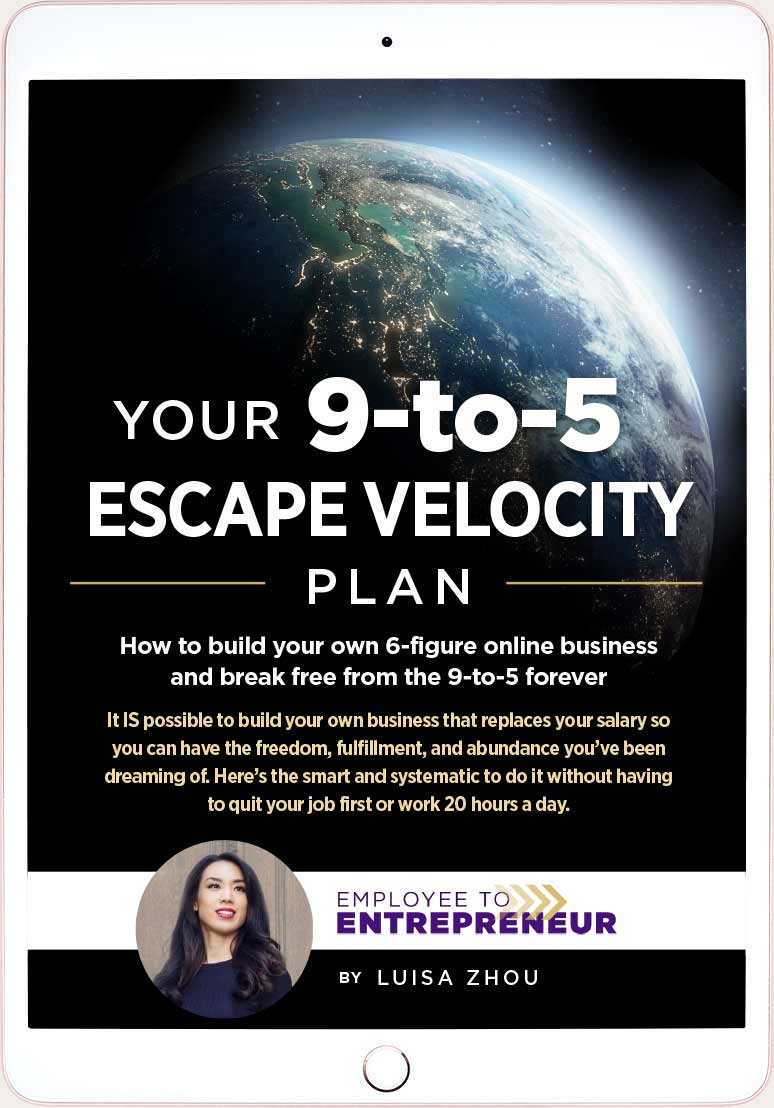What are the best coaching websites?
In this article, an expert web designer gives you her best tips on how to create coaching websites that stand out. You’ll also get some of the top coaching website examples out there.
Want to learn more? Read on!
What makes a good coaching website
How to create a coaching website
The best coaching website template
What makes a good coaching website?
Let’s start with what a good website includes.

To make this an incredibly valuable post, I asked one of the best designers out there, Laura Patricelli from Design Mastermind, what her top tips for building a website are. Laura and I have worked together for years, and she’s created my entire website including the blog you’re currently reading.
Here are the most important things to look out for on a website, according to Laura.
1. Calls to action (CTAs)
“Use clear calls to action on each page that reflect your ‘client experience roadmap.’ That’s the journey your ideal client takes, from first finding out about you to buying your signature offer to becoming a lifelong fan,” says Laura.
For instance, my own website includes visible calls to action, such as buttons to opt into my newsletter and coaching and product pages.
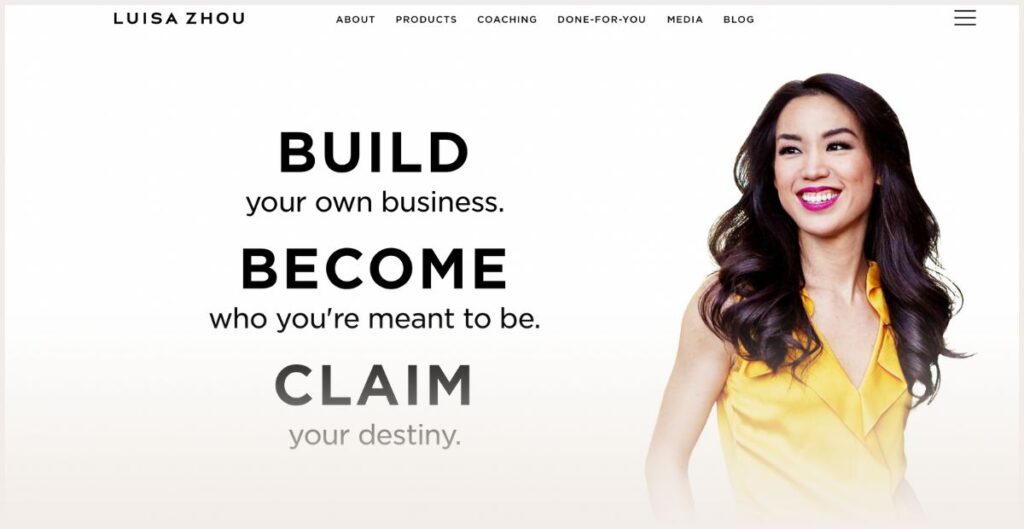
2. Clarity
According to Laura, your website should have to-the-point, easy-to-skim content that uses lots of headlines, sections, and bullet points to accommodate visitors’ low attention spans.
My website pages include white space, bolded text, images, and other elements that make the text easy to read:
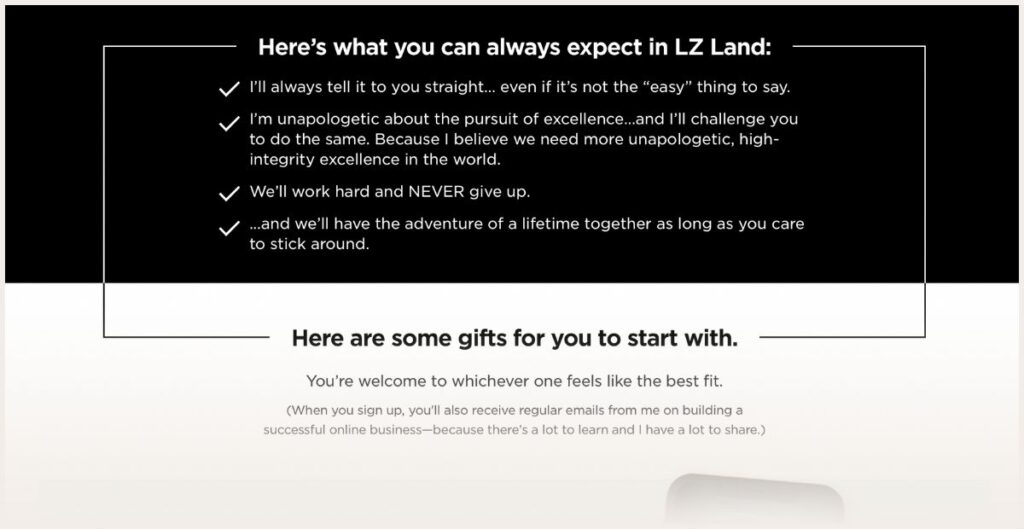
3. Professional branding and design
Laura says: “People can always tell when you’re cheap with your logo design or website. So, if you want to showcase yourself as a pro, you’ve got to look like one. Otherwise, people will be less willing to invest in your high-ticket services or packages.”
It all starts with creating a brand. And in this short video, I share my best tips on how to brand yourself as a coach:
4. Intuitive and easy-to-find navigation
“People hate searching around for things, so critical pages (such as ‘About’ and ‘Services’) should be clearly visible at the top of your page, not hidden away. This doesn’t apply to sales pages, though, since you really don’t want to distract visitors away from your offer,” says Laura.
In other words, use a navigation bar with your most important pages. Here’s my own website navigation:
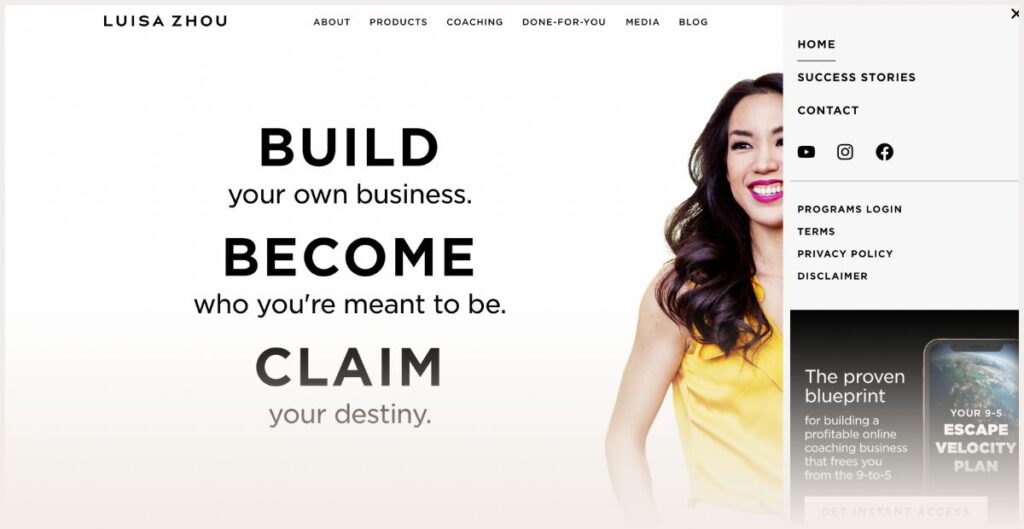
5. Speed optimization
Finally, website speed is crucial to how well your website performs. Page speed and conversions go hand in hand. Studies clearly show that the slower your website is, the lower your conversions will be.

How do you create a fast website, though? According to Laura:
Get the Ultimate Guide
for building a
6-Figure Coaching Business so you can achieve more freedom!
“Only use reduced-size images (less than 100kb), minimize your files as much as possible, and leverage services such as high-speed cloud hosting, page caching, and CDN (content delivery network). For example, videos at the top of your homepage may look amazing but they will absolutely tank your speed score.”
Now you know what makes a website stand out. But what does great website design look like?
Let’s find out.
The 20+ best coaching website examples
What are the best coaching websites? Here below are some of my favorite websites, including life coaches, health coaches and career coaches.
Best life coaching website examples
TonyRobbins.com
Why it works: Tony Robbins is one of the biggest names in coaching. His website includes a clear navigation bar with his top offers, a compelling call to action on the front page, and easy-to-read text.
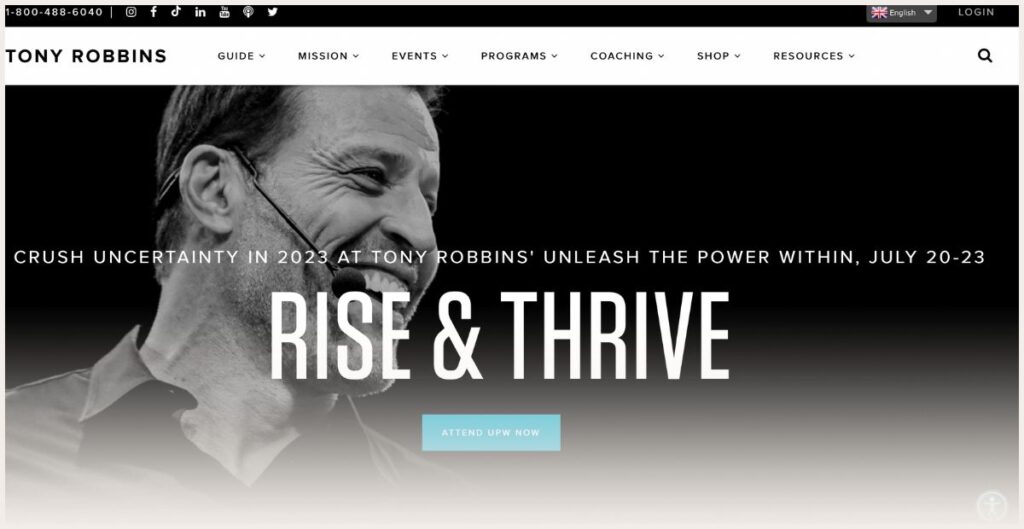
BreneBrown.com
Why it works: Theoretically, Brené Brown isn’t a coach, but her niche is self-development. The website design is clean and easy to navigate. You’ll quickly find her podcasts, books, and other offers.
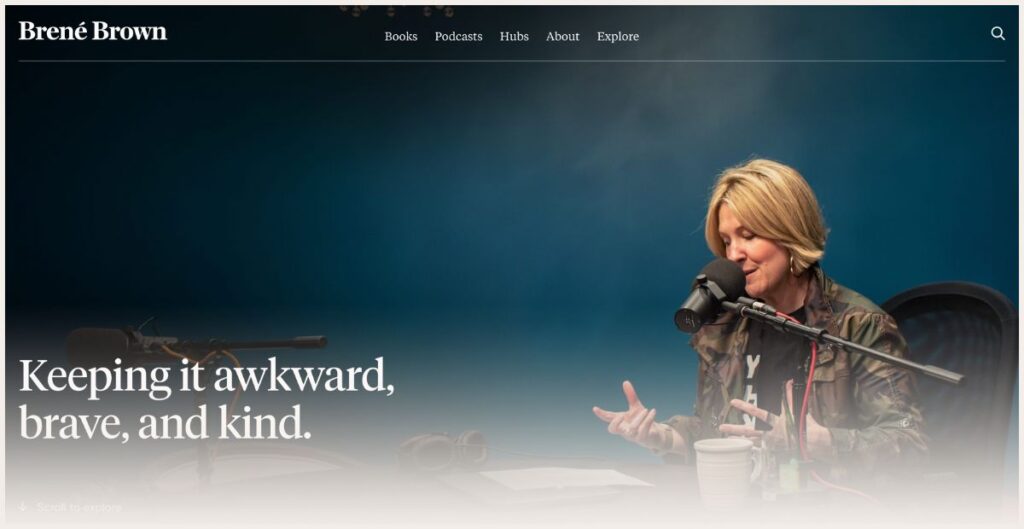
GabrielleBernstein.com
Why it works: Gabby Bernstein is a spiritual coach whose website is the perfect reflection of her edgy aesthetic: Neon contrasts with black and white to make the website engaging. Her website points to her free media, mailing list, and books.
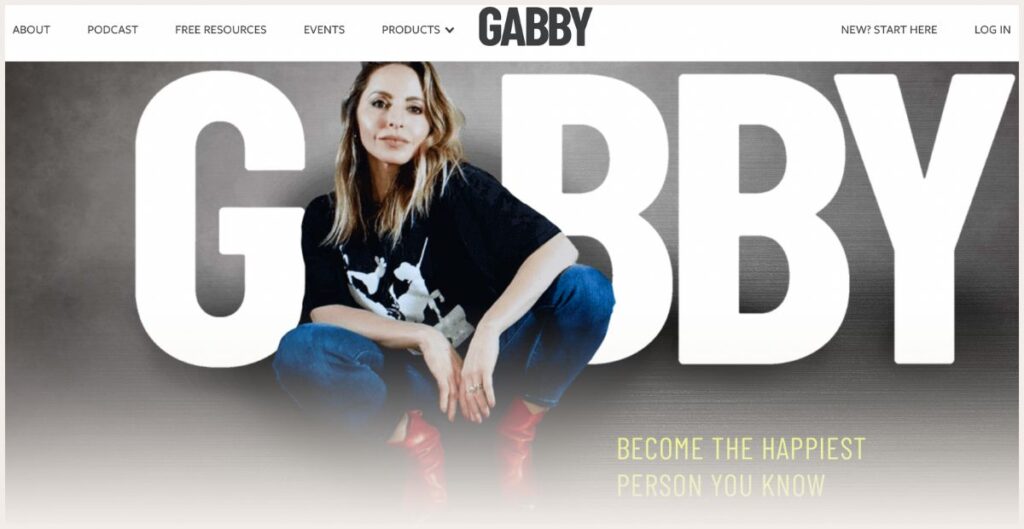
Susie-Moore.com
Why it works: Susie Moore runs a life coaching business with a positive, friendly brand. That’s why her website is colorful and pops with fun, conversational text.
Her website intro focuses on you, the visitor. This is an easy way of putting benefits first. Also, the top navigation has clear titles, and the “get in touch” CTA is in a bold color, which draws the eye.
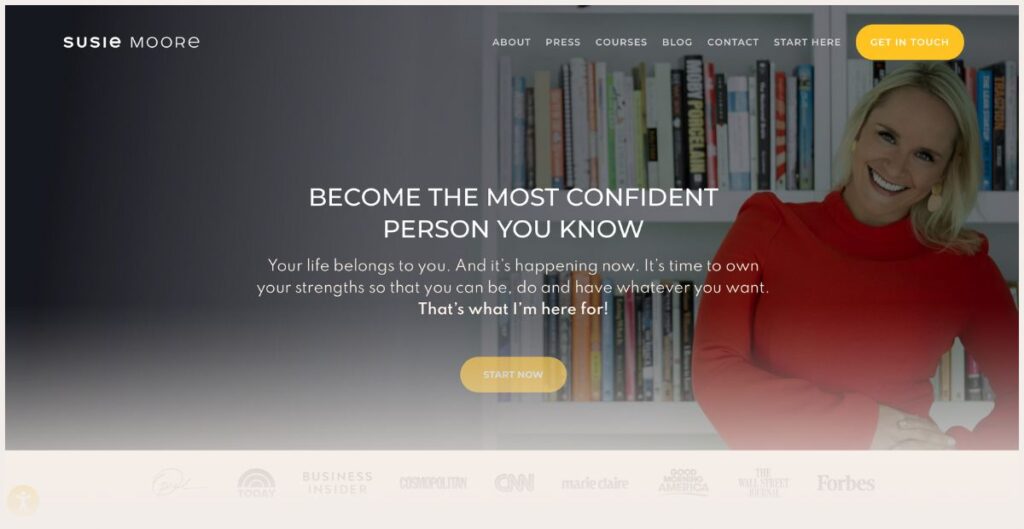
Best career coaching website examples
Cultivitae.com
Why it works: My student Emily Liou is in the career coaching niche. She helps candidates land their dream jobs and her website design is simple and positive, with clear copy and calls to action.
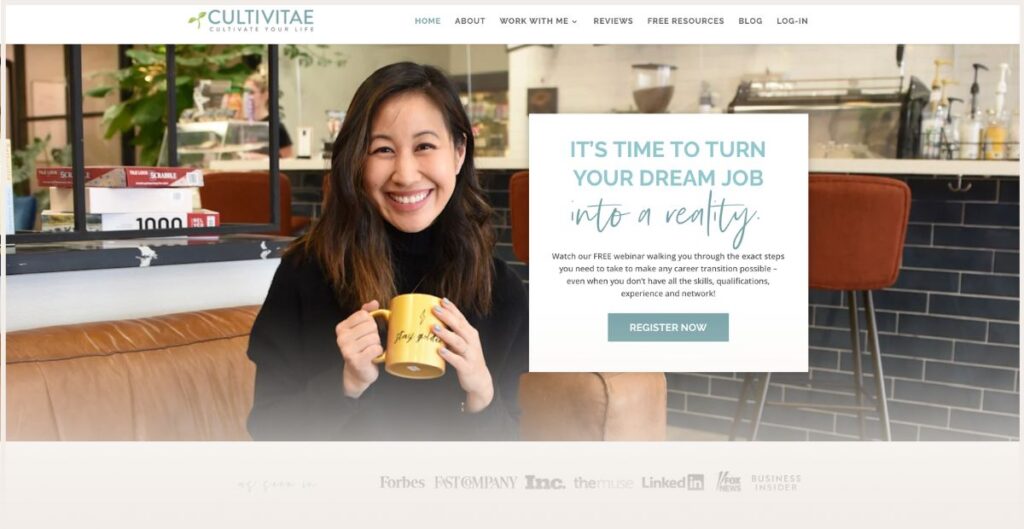
Employee Redefined
Why it works: Another student, Adunola Adeshola, is a career coach for millennials. From her header, you know exactly who she works with and how she helps them. And her website is simple, too, with five pages, making it easy to find what you’re looking for.

Best mindset coaching website examples
LowinaBlackman.com.au
Why it works: Lowina Blackman is a money mindset coach. Her website includes a navigation bar and clear CTAs with imagery and a color scheme that highlight her offer as a coach.
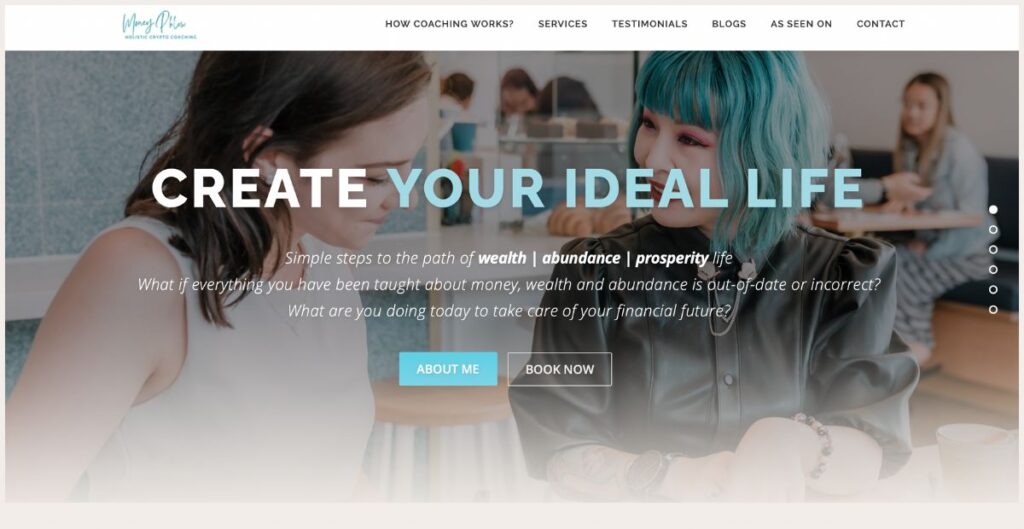
SusanFrancis.com.au
Why it works: Susan Francis is a spiritual mindset coach. She’s a great example of how to use impactful language to connect with your readers. The imagery and color scheme on her website are harmonious, which sets the tone for a calm, inspiring coaching experience. She also uses short CTAs to direct visitors through her site.
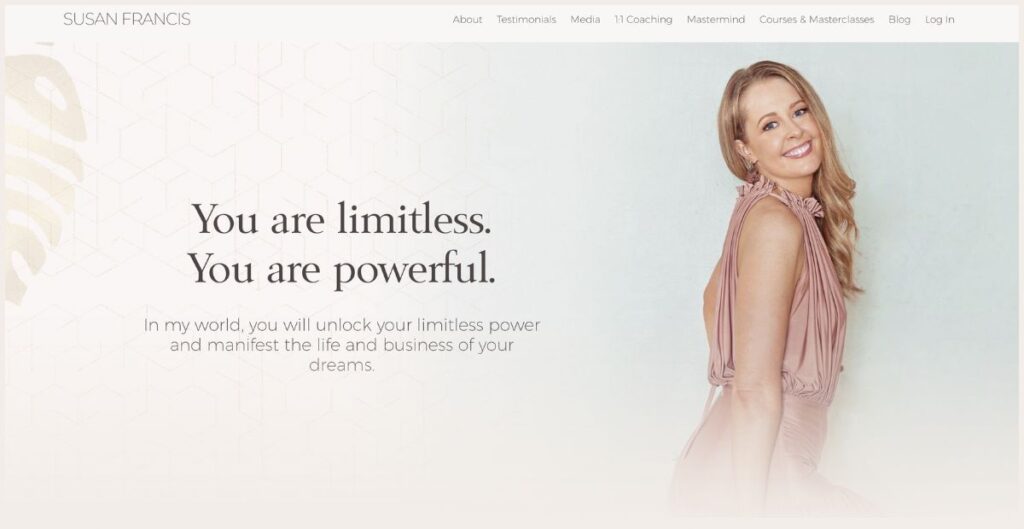
DrShannonIrvine.com
Why it works: Dr. Shannon Irvine, one of Laura’s clients, is a neuro coach with a dynamic website. With clear visuals and CTAs, her website is extremely easy to skim through. And thanks to compelling copy, it invites website visitors to take action.

Best business coaching website examples
MarieForleo.com
Why it works: Marie Forleo’s website is bold, just like her brand. However, her website includes a video, something that could impact page loading.
The website has six easy headings. And, with the “more” dropdown, she can add more pages to her website – without overwhelming visitors. To build trust and credibility, Marie highlights her appearances with high-profile celebrities like Oprah and Richard Branson.
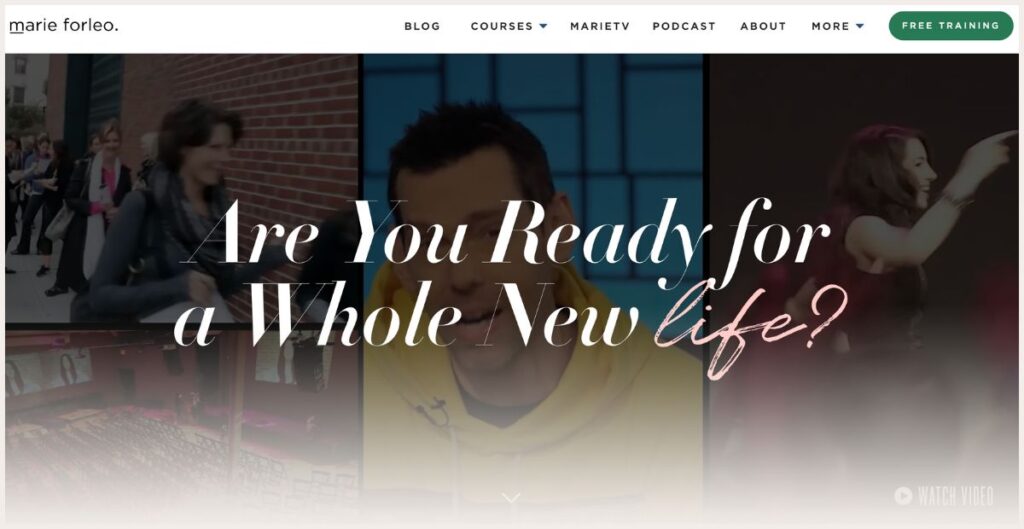
JennaKutcher.com
Why it works: Jenna Kutcher is a leading digital marketer and educator. Her website is a prime example of beautiful design paired with fun, personality-packed copy. Her site is easy to navigate with large sections to introduce different sides of her business and simple labels for fast navigation.
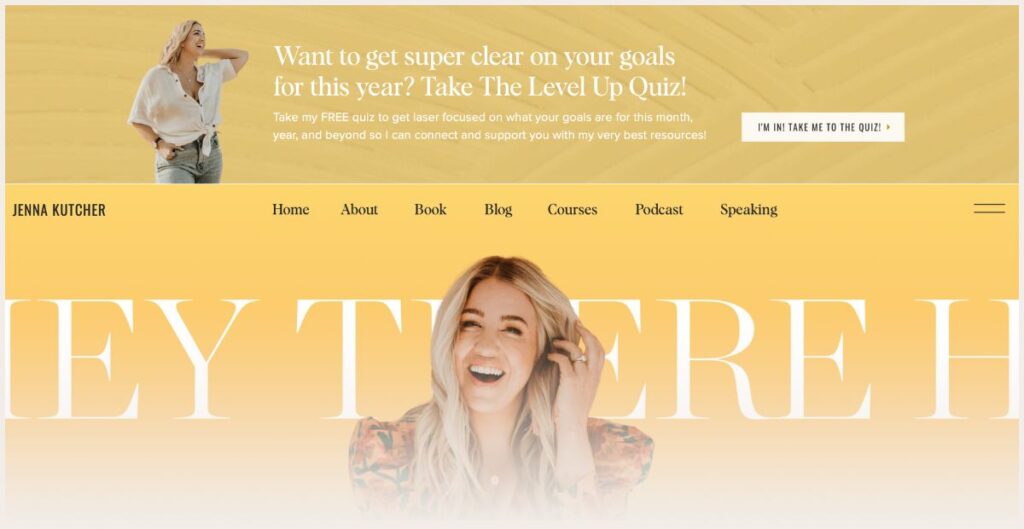
HelloSeven.co
Why it works: Hello Seven is a unique model for coaching because it’s a community that helps women who want to build amazing businesses. You get that community feel straight from the header image. With a quiz that directs visitors to the best resources for them, the website offers a lot of value.
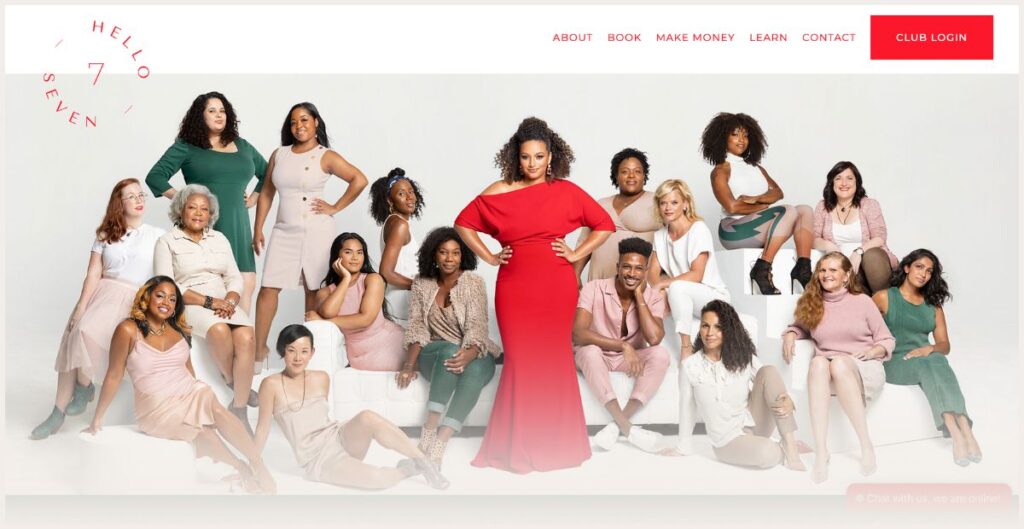
JaquelineMisla.com
Why it works: One of Laura’s clients, Jacqueline is a business and career coach who helps people make positive changes in their lives. From introducing Jacqueline with her mission and bio to showing different ways to engage with her work, the website flows nicely. Jacqueline’s website is built with Squarespace.

KristiSoomer.com
Why it works: Kristi Soomer is an e-commerce business coach, and her website uses neutral tones for a professional look. With just four headings, the site is easy to navigate. Right from the start, you immediately understand what Kristi does for her clients.

TheUncommonWay.com
Why it works: Jenna Harrison, one of my students, is an online business coach who specializes in helping people gain clarity around their business trajectories.
The “clarity” message is all over the homepage. Visitors know exactly what they’re getting.
The website also has crisp fonts and a neutral color scheme to look professional and trustworthy. Jenna uses short CTAs with action words. And, by making the buttons a contrasting color, visitors are more likely to click them.
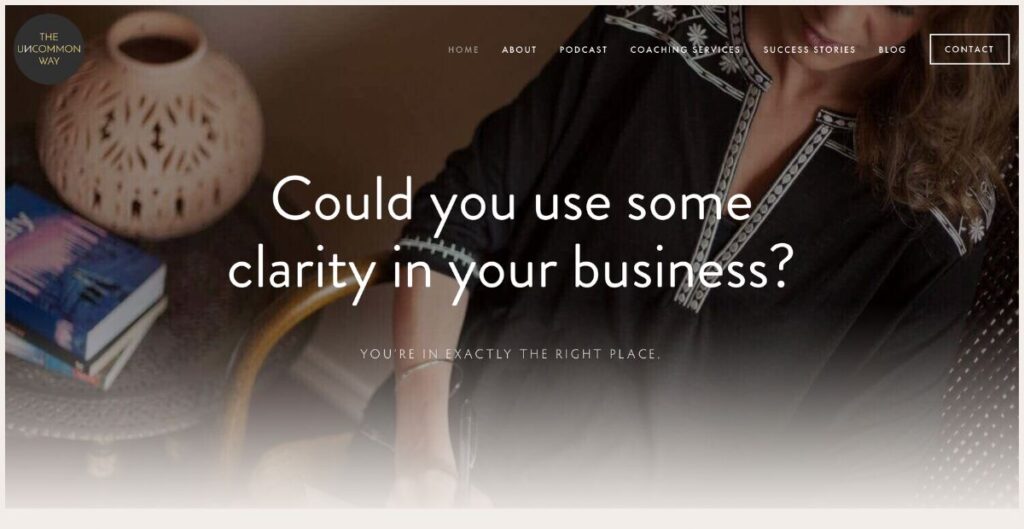
Best leadership coaching website examples
NishaMoodley.com
Why it works: Nisha Moodley is a leadership coach with an ethereal brand aesthetic. As soon as you land on her website, you understand the type of work she does and her philosophy.
Nisha shows how font, color, and image choice communicate your brand to potential clients. Her web copy is personable and soulful, and it introduces her work with clear, short sentences.
Also, the main navigation has just five headings, which makes it easy for people to find the information they’re looking for.
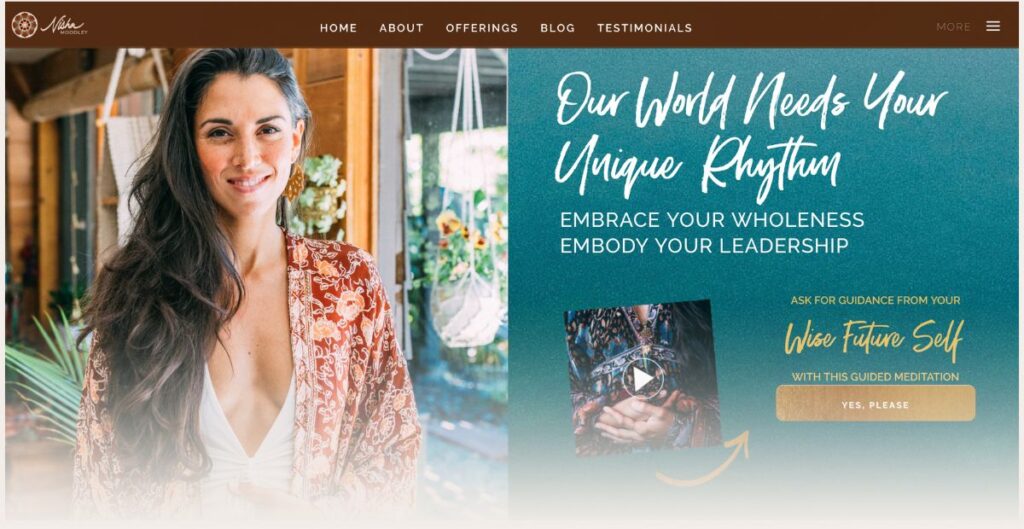
Best health coaching website examples
HeidiHauer.com
Why it works: Heidi Hauer is a holistic health coach whose website features an awesome header image. The website, starting from the homepage, is extremely clear and compelling with colors, bolded texts, and images that make the page easy and fun to read.

Best sales coaching website examples
SusanMcVea.com
Why it works: Susan McVea, one of my students, is a sales coach. Her website is super simple: It has a main homepage and two other master pages, which makes it easy to navigate.
Susan uses the classic technique of having a CTA on the header image to build her mailing list. So, if you want to get your web visitors engaged right away, this is a great way to do it.
To build trust, Susan chose to have testimonials on her homepage right after the opening lines. This helps her communicate the value of her coaching services before visitors get too deep into the website.

Best relationship coaching website examples
DatingTransformation.com
Why it works: Connell Barrett, a client of Laura’s, is a dating coach. With clear text and 3D effect buttons, the website uses plenty of images and videos to engage visitors and direct them to take action. Connell’s website is built with Oxygen.
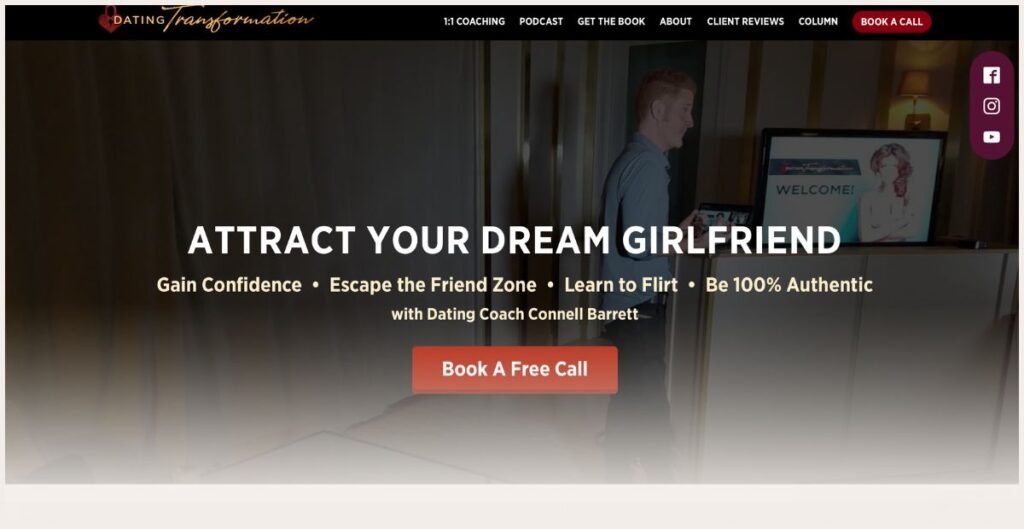
Now, let’s take a look at how to build your own website.
How do you create a coaching website?
Creating a website comes down to a few things, including structure, building trust, and getting your visitors to take the next steps to either join your audience or buy from you.
Laura shares these tips to help you get started:
- Offer tons of value to website visitors, both with and without a necessary opt-in. Your blog, if you have one, is a perfect place for this. People should want to give you their email because you’ve already given them something to work with and proven that you’re the go-to expert. So now, they’re itching for more!
- Be realistic about what you can and can’t do yourself. While there are a lot of DIY resources and templates available, there are still certain areas of your business that are best left to the experts. Unless you’re already a designer or developer, your audience will notice your attempts to DIY.
- Professional templates are worth the investment and will save you money in the long run. Once you have professional graphic and website page templates at your disposal, you can outsource to your virtual assistant (instead of a graphic designer) every time you want to create something new.
Get the Ultimate Guide
for building a
6-Figure Coaching Business so you can achieve more freedom!
And next, let’s take a look at the specific website creation steps.
1. Structure
A clean website structure draws in clients and increases sales.
Here are Laura’s tips on how to achieve that:
- Keep it simple. Make your About, Services/Sales and Contact pages super easy to find from any page on your website.
- Don’t give visitors too many options. Each page should have ONE specific call to action or “next step.” This doesn’t apply to your homepage, though, which should serve to target different types of visitors and then funnel them to different areas of your website.
2. Clear copy
Great coaching websites aren’t just about design. Copy matters, too. Here are my tips for crafting engaging copy for your website:
- Write clearly and concisely. Be personal, but also remember to be extremely clear – otherwise, your website visitors will leave.
- Focus on benefits. Clients want to work with you because of the results you create. So, instead of listing the features of your services, zero in on the benefits. What transformation will your clients go through with you? That’s what they want to know.
- Make it obvious what you do and who you work with right from the homepage. If you’re unsure if it’s clear or not, ask a brutally honest friend for feedback.
3. Call to action
A call to action is a prompt for the reader to do something. For example, “buy now”, “sign up”, and “get in touch.”
Sounds simple, but the right CTAs can 10x your conversions.
Here’s what Laura says about CTAs:
- Calls to action should be consistent throughout each page (except the homepage, which can have CTAs that link to multiple different pages). So, the buttons should all go to the same place, and the color and language used in each call to action should be identical.
- For high-ticket packages, offer spectacular guarantees. This will help bring in way more clients who are on the fence rather than cost you money in the long run.
- Always include secure payment logos for credit cards you accept. A lot of people have been scammed or had their credit card details stolen before, so accommodate their concerns.
To create email opt-in calls to action (like the one below), you need a plugin. PopupAlly is a good option.
Here’s one of my own email opt-in offers (created by Laura):
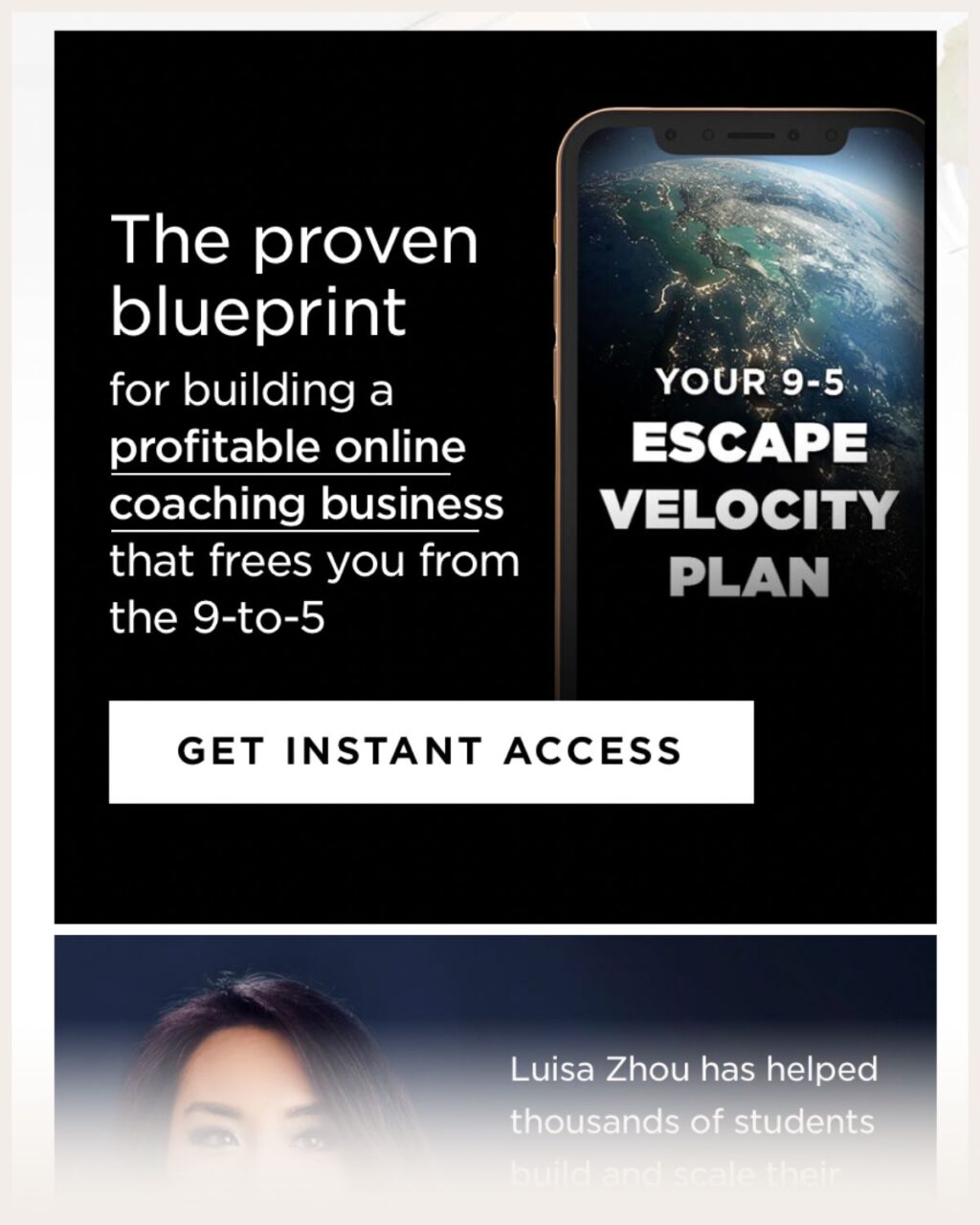
4. Trust
Clients buy from coaches they trust. Laura suggests these tips to build trust through your web copy:
- Showcase testimonials and “as featured” logos high up on the page. Only your BEST testimonials should be featured on your Services and About pages. The rest can be located on a separate ‘Praise’ page so they don’t take over your website and dilute the impact of your best client stories.
- A great way to showcase testimonials is via ‘case studies,’ where you use your own words to describe the transformation that your client experienced. You can then add in their own words (or a video, if you have one) to support your story.
For example, I use both testimonials and “as featured” logos on my own page:
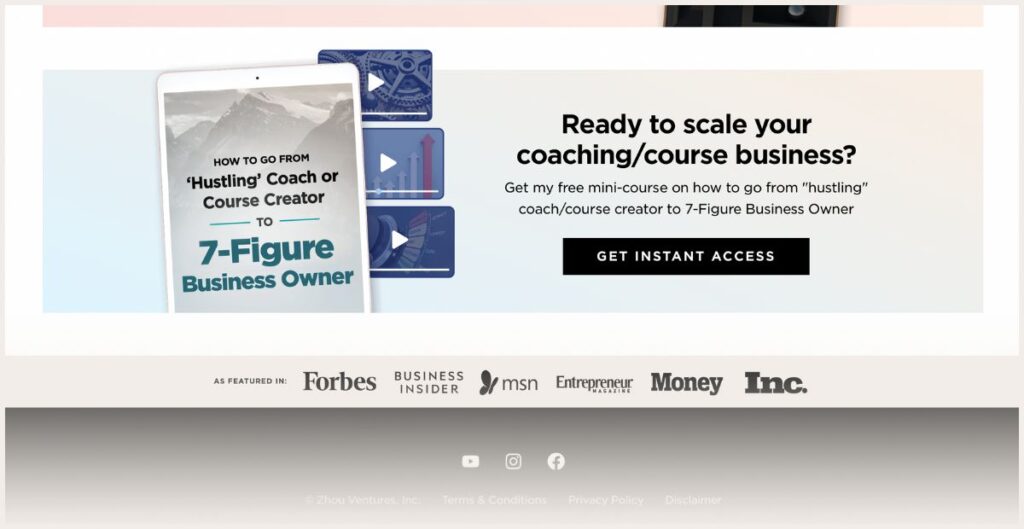
Want to know how to get more testimonials for your website? Check out this video:
The best coaching website templates
Finally, templates can be a good way to build your first, simple website, before you have the revenue to pay for a professional designer.
The template you use depends on your website platform, like WordPress, Squarespace, Webflow, Kajabi, or Showit. I personally prefer WordPress as the most flexible and best-performing platform.
As for WordPress templates, I recommend Elementor (starting at $9.99/month). Elementor is a drag-and-drop theme that lets you create beautiful websites.
Get the Ultimate Guide
for building a
6-Figure Coaching Business so you can achieve more freedom!
One of the best things about Elementor is that it has plenty of pre-made page layouts. You can use these for your different site pages.
If you hire a designer, they can use this template to design a fully customized website from scratch.
Over to you!
Now you know what great coaching websites look like and how to build your own.
Special thanks to my web designer Laura Patricelli. I can’t recommend her highly enough if you want professional help. You can learn more about her website packages here.
Now, I’d love to hear from you:
What’s your #1 question about creating a coaching website?
Let me know in the comments below.

